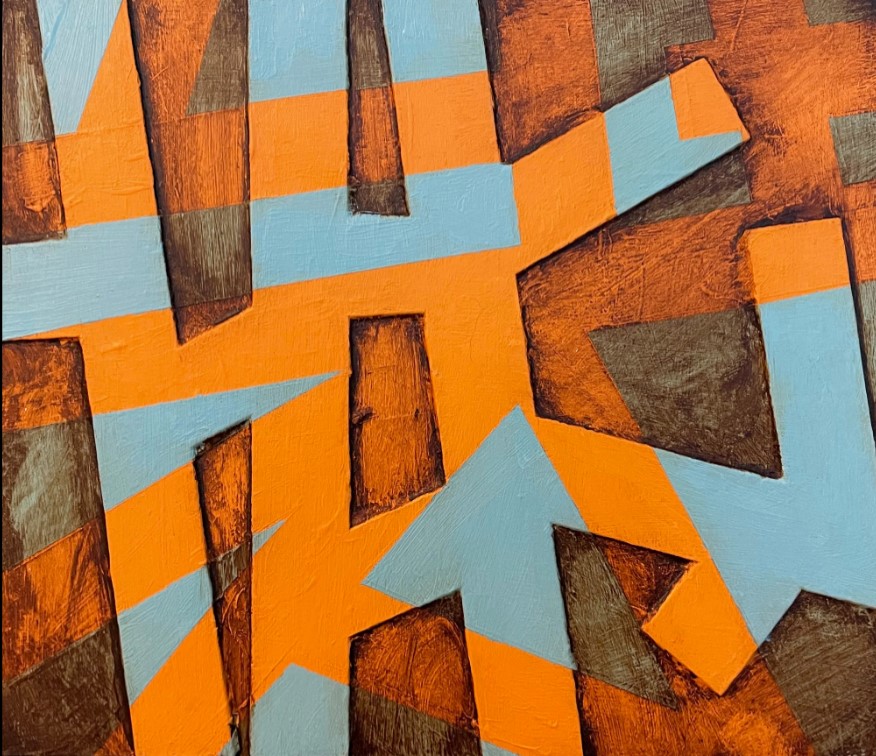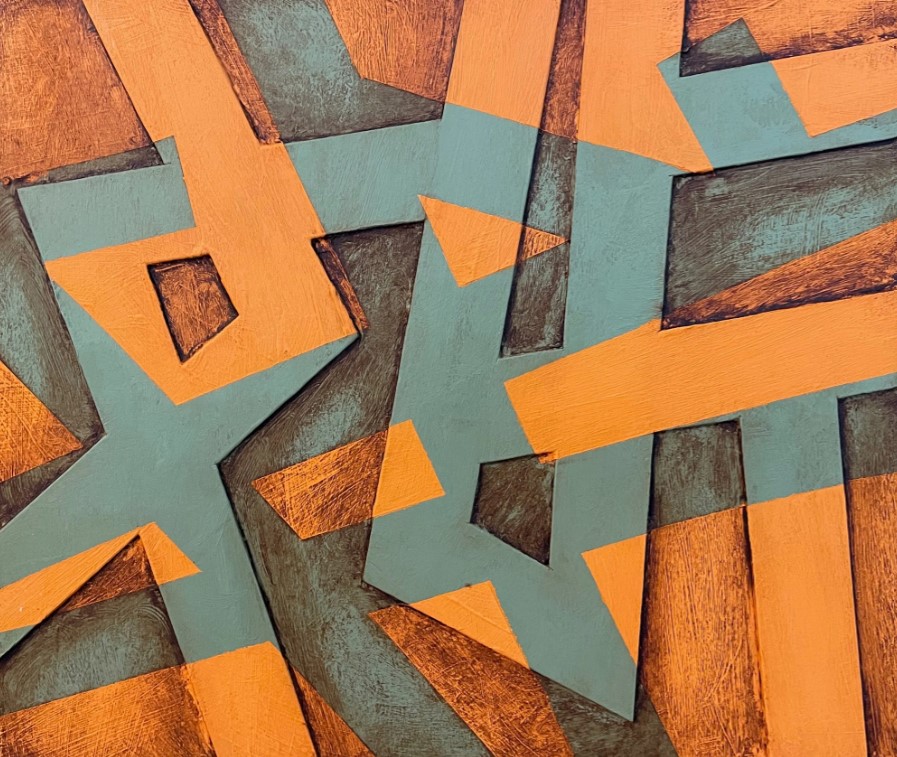We speak to artist, Friend of the RWA and acclaimed author Mark Haddon about his approach to art, how it relates to his writing, and more…
“…If I reach the end of day without having made some small new thing and put it into the world – whether it’s a paragraph or a picture of some kind – the day feels wasted and I feel out of kilter…”.
Mark Haddon is an author, illustrator and artist. His much-loved 2003 novel The Curious Incident of the Dog in the Night-Time gained him international recognition and a host of awards, including Whitbread Book of the Year, and was successfully adapted for the stage. Since then he has published numerous acclaimed novels and collections of short stories and poems.
A Friend of the RWA, Mark has three works in the current Friends’ Exhibition. We wanted to find out more about those pieces, as well as his approach to art and how it relates to his writing. Here’s our Q&A…
When did you realise you were an artist?
My father was an architect. He drew and painted, so my sister and I drew and painted, often on the back of spare plans he bought home from the office, those big, grey-blue sheets still tangy with ozone from the dyeline printer. My favourite subjects were underseas panoramas (deep sea divers! octopus! wrecks!) and castle sieges (trebuchets! boiling oil!). Later, I was steered away from art at school because they sensed they could get some “proper” A Levels out of me, and didn’t want me wasting my time in the art room and design centre (if I had my time again I’d ditch A Level economics and be in there like a shot).
I kept drawing and painting nevertheless and was able to get enough illustration work after university to avoid all those office jobs for which I was pathologically unsuited. I illustrated three of my own books for children and several for other people.
Slowly I moved away from illustration and crossed the border into “art”. Where does that border lie? Now there’s a subject for a very long conversation.
Why do you make art?
If I reach the end of day without having made some small new thing and put it into the world – whether it’s a paragraph or a picture of some kind – the day feels wasted and I feel out of kilter.

You have three works in the 2024 Friends of the RWA exhibition, and you’ve also contributed to the RWA’s Secret Postcard Auction… How did you come to be involved with the RWA – and what are your impressions of it?
I had a small sculpture was accepted for the 170th annual open exhibition in 2023 and found myself sitting on a plinth next to a piece by Patricia Volk. It was my first visit to the RWA and I became a fan immediately. That impression has only increased over time. The exhibitions are wonderful and the outreach work seems part of a genuinely welcoming atmosphere created by genuinely welcoming people (a special shout-out in that regard to Alison Bevan and Hemali Modha).
Can you tell us a little about the works in the Friends’ Exhibition – the Onkalo acrylic paintings, and the sculptural work Tanagra… The inspiration behind them, and the process of creating them?
I’ve realised recently that a great deal of my art harks back to the architectural models our father would occasionally bring home from the office when we were children, beautiful objects made out of white mountboard and PVA with little rectangles of acetate for the windows and tiny trees made of green sponge. If you peel away the brightly coloured surfaces of my sculptures you’ll find something similar, a geometrical skeleton of white mountboard over which I lay skin of newspaper and glue. The end results look very different from the houses, shops, factories and abattoirs my father designed but my sculptures are, in their own peculiar way, also buildings. Unlike sculptures made of stone or metal or wood of clay, there is a hidden structure which dictates the external shape. The paintings, too, are acrylic on cut and shaped mountboard.
I like the fact that these are not “prestige” art materials. I have always felt profoundly uneasy about the toxic relationship between art and wealth. So I make art out of cheap, everyday materials and sell it – when I sell it – for relatively low prices in the hope that it might sit in the home of someone who doesn’t normally feel able to own art.
A footnote about the painting titles Onkalo 5 and Onkalo 8. Onkalo is the name of a huge subterranean spent nuclear fuel storage project in Finland which was the subject of a gloriously spooky documentary Into Eternity by Michael Madsen which I recommend highly. One of the subjects which occupied the creators of the site was how to surround it with warning signs which would not only survive but be comprehensible to people in ten, twenty thousand years when contemporary languages and civilisations are all long gone. Those two ideas, of something invisible being radiated, and of the attempt to create some kind of universal language, often hover in the back of my mind when I’m thinking about abstract art.

You’ve achieved great international success and critical acclaim as an author… But how does your artwork relate to your writing, if at all? Are there similarities in the creative processes or are they completely different? And do you find one easier than the other?
I think to make half decent art of any kind– whether you’re singing an aria, throwing a pot or writing a haiku – you need the ability to wear two hats and swap between them easily and quickly. You need to be the maker, the performer, you need to immerse yourself in the work. But you also need to be able to step back and see what you’re doing through the eyes of a complete stranger and be ruthlessly objective. Does this work? Does this move me?
More specifically, I’m a very visual, physical writer as befits the son of an architect. Just as every piece of art I make is, in some way, a building, I can’t write without imagining in great detail the building or landscape within which any scene is taking place. Sometimes I will go so far as to draw maps and plans which act as scaffolding which I throw away when the text is finally finished.
On a purely literal level, I have sometimes included my artwork in my books (and not just the children’s picture books). The illustrations in Curious Incident, for example, were all done using a mouse and the lo-fi, pixel-y Paint program which used to come bundled with Windows.
Most of the time, however, I find solace in sculpture and painting because it enables me to create something without having to use any words at all.

Are you a collector of art? Any favourite contemporary artists?
We have a small and very beautiful landscape by Tai-Shan Schierenberg hanging over the mantelpiece. I also have a number of unsigned Hockney etchings from his Grimms’ Fairy Tales suite which have bewitched me since I first saw them as a teenager. If we include ceramics I’m drinking tea at this very moment from a splendidly wonky mug by Jean-Nicolas Gérard who also made the equally beautiful bowl from which I’ve just eaten my muesli.
As for my favourite contemporary artists…? OK, deep breath. Gerhard Richter, Marlene Dumas, Phyllida Barlow, Oscar Murillo, Doron Langberg, Jennifer Packer, Howard Hodgkin, Matthew Ronay, Mark Bradford, Njideka Akunyili Crosby, Bridget Riley, William Kentridge… is that enough to be going on with?
What are you working on now?
I’ve had mid-level but persistent long covid for nearly two years now. During brief gaps in the brain-fog, however, I have managed to edit and pull together a collection of short stories, Dogs and Monsters, which comes out in August. The rest of time, art has been a lifeline. A novel or a short story is too big and complex construction to be seen in its entirety in the narrowed focus of my mind’s eye, but I can imagine a sculpture or picture and know whether it stands a reasonable chance of working if I build it in the real world.
A fairy godmother waves her magic wand and says you can own any artwork in the world. What do you choose?
Ooh, it’s a toss-up between Abstraktes Bild (Abstract Painting), 2016, a Gerhard Richter squeegee painting I fell in love with at the recent David Zwirner Exhibition in London, and Marlene Dumas’ Jule-die Vrou, a portrait from 1985. I have to choose? All right, I’ll go for the Richter.
See more of Mark’s art at markhaddon.com and on Instagram @mjphaddon.
The Friends Exhibition runs until 28 April in the downstairs galleries at the RWA (free entry). Works can also be bought online.
Portrait top: credit Charles Moriarty

